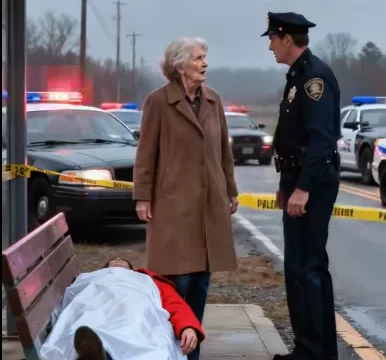She sits behind cold, unyielding metal bars — barely a teenager, her future stripped away before it even had a chance to unfold. Her only crime was being in the wrong place at the wrong time, trapped in a system that often sees punishment as the only answer. In a nation that calls itself the land of freedom and opportunity, there exists a haunting contradiction: children, some as young as twelve, sentenced to spend the rest of their lives behind prison walls without the possibility of parole.

The United States, celebrated around the world as a beacon of liberty, holds one of the largest prison populations on the planet. Yet hidden within those numbers are stories that defy belief — at least seventy-nine children under the age of fourteen serving life sentences with no chance of release. This data, reported by Human Rights Watch and the Equal Justice Initiative, has reignited a painful conversation about what justice truly means in a society that claims to value redemption.
Behind those statistics lie lives filled with trauma, poverty, and lost potential. Many of these young offenders grew up in homes defined by instability — where violence was a daily occurrence, education a distant dream, and survival the only goal. Some committed terrible acts, yes, but others were mere bystanders or accomplices in tragic situations they neither initiated nor understood. Each story is layered with complexity and pain, revealing how quickly childhood can disappear in a system that prioritizes punishment over understanding.
One case that forced the nation to look closer was that of Lionel Tate. In 1999, at just twelve years old, Tate was convicted of killing a six-year-old girl during what he said was a wrestling game gone horribly wrong. Though he claimed it was an accident, the court sentenced him to life in prison without parole — making him the youngest American at that time to receive such a sentence. Public outcry followed, with advocates arguing that a twelve-year-old child could not possibly comprehend the consequences of his actions the same way an adult could. After years of appeals and public pressure, Tate’s sentence was eventually reduced, but his story left a permanent mark on the national conscience. It became a turning point, sparking the question that continues to haunt America: should children ever be tried and sentenced as adults?
The debate cuts to the core of morality, science, and justice. Experts in psychology and child development agree that young brains are still forming — meaning that impulse control, emotional regulation, and moral reasoning are far from fully developed. “Sentencing a child to life in prison violates the most basic principles of justice and humanity,” said Juan Méndez, former United Nations Special Rapporteur on Torture. “Children are still developing — emotionally, mentally, and morally. To condemn them to die in prison is to deny them the possibility of growth, redemption, and change.”
Despite such statements, many states remain reluctant to soften their stance. Florida, Michigan, and Pennsylvania lead the nation in the number of minors serving life sentences. Lawmakers and prosecutors in these states often argue that certain crimes are so severe that age should not shield the offender from the harshest punishment available. For them, justice for victims and public safety outweighs the argument for rehabilitation.
However, over the past decade, some progress has been made. In 2012, the U.S. Supreme Court ruled that mandatory life sentences without parole for juveniles were unconstitutional, recognizing that children’s capacity for change distinguishes them from adults. Four years later, in 2016, the Court extended that decision retroactively, meaning those already serving such sentences could have their cases reviewed. Yet even with this ruling, hundreds remain behind bars, waiting for their chance at reconsideration — some for years, trapped in legal limbo.
Civil rights advocates, including renowned attorney Bryan Stevenson of the Equal Justice Initiative, continue to push for reform. “Childhood should be a time for learning and redemption, not a life sentence,” Stevenson said. “When we decide a child can never change, we abandon both science and compassion.” Stevenson’s work, which inspired the award-winning film Just Mercy, has brought renewed attention to how deeply racial and economic inequality intertwines with juvenile sentencing. Studies show that children of color, particularly Black boys, are far more likely to receive life sentences than their white peers for similar offenses.
Advocates are calling for a system rooted in restorative justice — one that recognizes harm but seeks healing rather than lifelong punishment. Programs that focus on education, therapy, and community reintegration have shown success in helping former juvenile offenders rebuild their lives. These approaches don’t erase accountability; instead, they acknowledge that transformation is possible.
Opponents of harsh juvenile sentencing argue that redemption is not only a human right but also a societal necessity. When a system closes the door on rehabilitation, it sends a dangerous message — that some lives are beyond saving. “If we give up on our children, we give up on our future,” Stevenson often reminds audiences.
The debate surrounding these young inmates forces America into a moral reckoning. What does it mean to be a just nation? Is justice about retribution, or is it about restoration? The treatment of the most vulnerable — the children who made mistakes before they even understood the weight of consequence — reflects the true measure of a society’s humanity.
In prisons across the country, there are teenagers who have already spent more years behind bars than they did in freedom. Some were barely old enough to drive or attend high school. Many have found faith, pursued education, or mentored other inmates — small acts that show the capacity for change remains alive even behind concrete walls. Yet for too many, the system offers no second chance, no light beyond the bars.
As policymakers and citizens grapple with this reality, one truth becomes undeniable: justice without mercy is not justice at all. To rebuild a fairer system, America must find the courage to look beyond punishment and believe in the possibility of renewal. The call for reform is not about excusing wrongdoing — it is about recognizing that no child is born irredeemable.
The plight of these seventy-nine children serves as a haunting mirror reflecting America’s contradictions. The same nation that champions freedom and opportunity also holds its youngest citizens captive to a lifetime of regret. Each of those children’s stories challenges society to confront an uncomfortable truth: a country that cannot forgive its children cannot truly call itself free.
So the next time we hear the phrase “land of the free,” perhaps we should think of those young faces staring through iron bars — not as monsters, but as reminders of what justice could be if it chose compassion over condemnation.
If this story moved you, please share it with your family and friends on Facebook. Change begins with awareness, and awareness begins with stories like these — stories that remind us that even behind bars, hope can still find a way to breathe.





